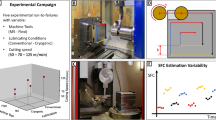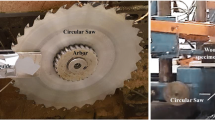Abstract
This paper presents a new approach to sensor based condition monitoring using a self-organizing spiking neuron network map. Experimental evidence suggests that biological neural networks, which communicate through spikes, use the timing of these spikes to encode and compute information in a more efficient way. The paper introduces the basis of a simplified version of the Self-Organizing neural architecture based on Spiking Neurons. The fundamental steps for the development of this computational model are presented as well as some experimental evidence of its performance. It is shown that this computational architecture has a greater potential to unveil embedded information in tool wear monitoring data sets and that faster learning occurs if compared to traditional sigmoidal neural networks.
Similar content being viewed by others
Explore related subjects
Discover the latest articles, news and stories from top researchers in related subjects.References
Aliustaoglu C., Ertunc H., Ocak H. (2009) Tool wear condition monitoring using a sensor fusion model based on fuzzy inference system. Mechanical Systems and Signal Processing 23: 539–546. doi:10.1016/j.ymssp.2008.02.010
Balazinski M., Czogala E., Jemielniak K., Leski J. (2000) Tool condition monitoring using artificial intelligence methods. Engineering Applications of Artificial Intelligence 15: 73–80. doi:10.1016/S0952-1976(02)00004-0
Bugmann G. (1997) Biologically plausible neural computation. Bio Systems 40: 11–19. doi:10.1016/0303-2647(96)01625-5
Byrne G., Dornfeld D., Inasaki I., Ketteler G., Konig W., Teti R. (1995) Tool condition monitoring (TCM)—the status of research and industrial application. Annals of CIRP 44: 541–567. doi:10.1016/S0007-8506(07)60503-4
Choudhury S., Jain V., Rao C. (1990) On-line monitoring of tool wear in turning using a neural network. International Journal of Machine Tools & Manufacture 39: 489–504. doi:10.1016/S0890-6955(98)00032-7
Cybenko G. (1989) Approximation by superposition of a sigmoidal function. Mathematics of Control, Signals, and Systems 2: 303–314. doi:10.1007/BF02551274
Dimla D. (2000) Sensor signals for tool-wear monitoring in metal cutting operations—a review of methods. International Journal of Machine Tools & Manufacture 40: 1073–1098. doi:10.1016/S0890-6955(99)00122-4
Dimla D., Lister P., Leighton N. (1997) Neural network solutions to the tool condition monitoring problem in metal cutting – a critical review of methods. International Journal of Machine Tools & Manufacture 37: 1219–1241. doi:10.1016/S0890-6955(97)00020-5
Gerstner W. (1999) Spiking neurons. In: Maass W., Bishop C. (eds) Pulsed neural networks. MIT Press, Cambridge
Gerstner, W. (2002). Integrate-and-fire neurons and networks. In M. A. Arbib (Ed.), The handbook of brain theory and neural networks (2nd ed., pp. 577–581). Cambridge, MA: The MIT Press.
Hodgkin A., Huxley A. (1952) A quantitative description of membrane current and its application to conduction and excitation in a nerve. The Journal of Physiology 117: 500–544
Hornik K., Stinchcombe M., White H. (1989) Multilayer feedforward networks are universal approximators. Neural Networks 2: 359–366. doi:10.1016/0893-6080(89)90020-8
ISO 3685. (1977). Tool-life testing with single-point turning tools.
Jantunen E. (2002) A summary of methods applied to tool condition monitoring in drilling. International Journal of Machine Tools & Manufacture 42: 997–1010. doi:10.1016/S0890-6955(02)00040-8
Kohonen T. (1990) The self organizing map. Proceedings of the IEEE 78: 1464–1480. doi:10.1109/5.58325
Lennox B., Montague G., Frith A., Gent C., Bevan V. (2001) Industrial application of neural networks—an investigation. Journal of Process Control 11: 497–507. doi:10.1016/S0959-1524(00)00027-5
Maass W. (1997) Networks of spiking neurons: The third generation of neural network models. Neural Networks 10: 1656–1671. doi:10.1016/S0893-6080(97)00011-7
Maass W. (1999) Computation with spiking neurons. In: Maass W., Bishop C. (eds) Pulsed neural networks. MIT Press, Cambridge
Maass W., Ruf B. (1999) On computation with pulses. Information and Computation 148: 202–218. doi:10.1006/inco.1998.2743
Natschläger T., Maass W. (2002) Spiking neurons and the induction of finite state machines. Theoretical Computer Science 287: 251–265. doi:10.1016/S0304-3975(02)00099-3
Parlos A., Rais O., Atiya A. (2000) Multi-step-ahead prediction using recurrent neural networks. Neural Networks 13: 765–786. doi:10.1016/S0893-6080(00)00048-4
Salgado D., Alonso F. (2007) An approach based on current and sound signals for in-process tool wear monitoring. International Journal of Machine Tools & Manufacture 47: 2140–2152. doi:10.1016/j.ijmachtools.2007.04.013
Silva, R. G., Reuben, R. L., Baker, K. J., & Wilcox, S. J. (1995). A neural network approach to tool wear monitoring. In 8th International Congress on Condition Monitoring and Diagnostic Engineering Management, Queen’s University–Kingston, Ontário, Canada, June 26–28.
Silva R., Reuben R., Baker K., Wilcox S. (1998) Tool wear monitoring of turning operations by neural network and expert system classification of a feature set generated from multiple sensors. Mechanical Systems and Signal Processing 12: 319–332. doi:10.1006/mssp.1997.0123
Silva R., Reuben R., Baker K., Wilcox S. (2000) The adaptability of a tool wear monitoring system under changing cutting conditions. Mechanical Systems and Signal Processing 14: 287–298. doi:10.1006/mssp.1999.1286
Sun J., Hong G., Wong Y., Rahman M., Wang Z. (2006) Effective training data selection in tool condition monitoring system. International Journal of Machine Tools & Manufacture 46: 218–224. doi:10.1016/j.ijmachtools.2005.04.005
Warnecke, A., Jenewein, A., & Reinfelder, A. (1990). Tool monitoring based on process identification, monitoring and control for manufacturing processes. In Winter Annual Meeting of the ASME, Dallas, TX, USA, pp. 43–55.
Author information
Authors and Affiliations
Corresponding author
Rights and permissions
About this article
Cite this article
Silva, R.G. Condition monitoring of the cutting process using a self-organizing spiking neural network map. J Intell Manuf 21, 823–829 (2010). https://doi.org/10.1007/s10845-009-0258-x
Received:
Accepted:
Published:
Issue Date:
DOI: https://doi.org/10.1007/s10845-009-0258-x




